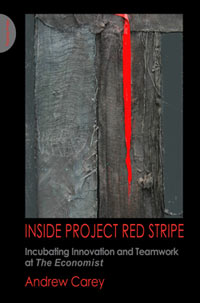|
Imprint: Triarchy Press
Published: 2008 List Price: £20.00 Offer Price: £16.00 Format: Paperback Extent: 232pp. Size: 15 x 23 cm ISBN: 978-0-9550081-6-0 Tags: Innovation, Teamwork, Design Thinking, The Economist Inside Project Red Stripe: Incubating Innovation and Teamwork at The Economist Andrew Carey Book Page About the author Contents Buy the book
Paperback:
|
Ramming Speed

Tom: ‘Six may be too many for a creativity team. There are too many constituencies. There aren’t many bands which have got six songwriters trying to write the same song.’
This is going to be a noisy business, I thought, when I was invited to write this book. Ships at a distance have every man’s wish on board, as Zora Neale Hurston put it. And Project Red Stripe was certainly a wish-laden ship; one laden to the gunwales with the hopes and dreams of its participants, with the envious, spiteful or generous watchings of its onlookers, and with the cautious optimism of its Economist Group benefactors. There was already a buzz in October 2006. A web search for Project Red Stripe led me to this: Economist’s New Digital Incubation Unit, Project Red Stripe A rather intriguing new digital incubation unit has been formed by the Economist Group, headed by Mike Seery, the CIO of The Economist Group. The new unit/project is called Project Red Stripe, and is based out of London. The mandate is to bring a new product to market… For now the group is bringing together a bunch of Economist employees to work on this full time, from the ideation phase through completion and launch. This unit… is completely independent, though funded by the parent company. Depending upon the kind of product it comes up with, it could wind up being spun off by the parent as a new company. Interesting coverage, this.First, it was a reminder that no-one at The Economist was trying to keep the project secret. And, second, the blog was that of journalist Rafat Ali (interviewed for Wired Magazine in 2003 and editor of a site that won the European Online Journalism Award in the same year and is now the foremost web-based source of information on digital content and digital media). I doubt that Rafat had learnt about Red Stripe entirely through his own investigative efforts. If the project team were as punctilious with their project development as with their PR, I thought, they should do well. And, of course, there’s this book. In a wired age more than ever, it matters how things are seen. And who sees them. It was clear that The Economist (or the project team, at least) was not only going for ‘transparency’ on this project, but also for a high profile. High profile means high risk. Whatever happened to Project Red Stripe was going to happen very much in the public eye. Project team members would be writing their own public blogs during the course of the project. As well as deciding to solicit ideas from the world at large, they would publicly describe what was happening in the team. Ludwig would even ask the others at one point, ‘Do we put the steps of the [idea-gathering] process onto the public blog and have people comment on it?’ Which would have meant inviting the world-out-there to comment on how the team was going to ask the world-out-there for their ideas. I was reminded of Knots. Clearly, being in the public eye was part of the excitement. In fact, project team hopefuls had been writing blogs and creating their own websites since Red Stripe was announced. Stewart had created www.pickmemike.com (designed to get project leader Mike Seery to pick him, obviously enough). The Home page announced: Project Red Stripe Needs Me Because My Ideas Are Great And Tom Shelley’s blog had been talking about Red Stripe since September 20th. By October 16th he was saying stuff like this: What speed for Project Redstripe? Ramming speed. That is the speed that I would like to see on Project Red Stripe. We’ll have the honour of working on the coolest project in the world. It’s our duty to the history of The Economist to give it everything. I want to order pizza in when we’re working late on something that absolutely has to get done. I want to hook up at weekends to work through unexpected bugs. I want to do the web startup thing until, when we finish, everything I’ve got will be in that bloody project. (Tom’s use of the word duty connects with only a little contrivance to Fichte’s observation about duty [discussed in Equifinality]). Tom’s blog got me thinking about people’s perceptions of this thing. It was turning into a performance. Let’s do it like they do it in the movies. The late-night pizzas in particular put me in mind of The West Wing, (though Mike reminds me that pizzas are the staple diet on techie projects and the now infamous Robert Scoble (of Facebook/Plaxo fame) has a picture of a few manly men ‘developing and deploying late at night’ and eating pizza at Microsoft). I didn’t know what Tom’s particular frame of reference was, but I guessed Hollywood was in there somewhere. Late night meetings where the future of the world is decided by people who are way too busy to have relationships, or cook. Tom, at least, seemed to me to be building this thing up until it was as big and exciting as anything he’d ever dreamt of. And nothing wrong with that. Talking it up would certainly get the creative energy flowing.
Back to his blog: who knows what ramming speed is? OK, Google tells me it’s computer games with Viking longboats and projectiles that go at five times the speed of sound. Google also tells me that in Army of Darkness, the little Ashes yell ‘ramming speed’ before stabbing Ash with the fork. Mike thinks it comes from The Blues Brothers, but I can’t find it – only a 1996 film called Ramming Speed, whose plot is given 10 stars and the following description by amateur critic rodeojimbo: ‘Some crazy crank dealers in Texas go berzerk and kidnap a dorky schmuck for fun.’ Now a dork is, apocryphally, a whale’s penis, but let’s not go there. Ramming speed is clearly fast. ‘What speed for Project Red Stripe? Jolly fast’ wouldn’t have been so good. Then, some time over Christmas I read this on Tom’s blog: Yes! I got on Project Redstripe Yes! Yes! Yes! Yes! I’m on the team. I got it. I did it. Mouth, sing it to the sky: ‘I’m doing the coolest job in the world’. If I were Alan Shearer I’d be peeling away to the Milburn Stand with my right hand in the air. And, if I were a bell, I’d be ringing. …Oh, oh, oh my! I’m torn between recording this moment, eating a delicious platter of cheese and ringing everyone to tell them the news. There’s an unashamed joy here. And an unashamed admiration for The Economist. In my day (that’s, say, 25 years ago), we’d have been very, very reticent in the UK about splashing our dressing like this, either publicly or in private, especially about our employer. It would very definitely not have been cool. As I wrote at the time, ‘I haven’t met Tom yet. He may not be cool. But I think he probably is. I doubt his friends are cackling hideously about him. I imagine they’re celebrating too. Yes, I find they are. There’s a YouTube video of them driving to Barcelona in two cars and throwing things at each other on the motorway. They seem happy. I think there’s going to be some enthusiasm in this Red Stripe. Some energy.’
In July, near the end of the project, Tom would say to me, ‘There’ll be times when I get excited about things and it gets discounted by the others because I get excited by a lot of things. Because everyone knows the next thing’ll be along in a minute.’
On the other hand, Mike would say to me, ‘When you talk to other people about [the project], that’s when you feel good. You feel more fired up and energised. Tom’s good at that. He gets that anyway.’ On January 15th, Mike announced the team members on the Red Stripe website: Steven Chiu Stewart Robinson Mike Seery Tom Shelley Ludwig Siegele Joanna Slykerman Nothing more than that. Just their names. He had already told me a little about his intentions at our first meeting. He was looking for someone from Editorial for ‘gravitas’ and someone from Sales, because ‘they understand the market and how to reach it’, and someone who really understands the technology ‘to handle the third party provider’ (Mike was clear that they would be using outside experts actually to build whatever website/Internet idea they settled on, and make it happen.) But the names weren’t certain then. Now they were and so I went searching: We’ve met Tom Shelley via his blog. He describes himself as an ‘Economist sales stooge’. He was going to find Red Stripe a lot more exciting than his regular job. He had his first gig as a stand-up comedian in July 2007. If you see his name in Time Out, go and listen to him. Steven was Senior Business Development Manager for The Economist Group in Beijing. ‘I was a sales guy,’ he said later. Mike had told me about a ‘project-team possible’ in Beijing. He said there might be problems because of his existing work commitments. In theory, he said, no-one at The Economist could stop anyone else being part of the team. But, in practice, he agreed that he might need to make some concessions. He didn’t want to make too many enemies. He also said he was looking for people who wanted to go back to their jobs after the project – not for people who were trying to escape them or looking for a six-month holiday. (When the team met, its members were interested to discover that five out six of them intended not to go back to their original role.) There was almost nothing about Steven on the Web. Later I learnt that he is from Newfoundland, where they don’t need to make artificial fog. When I asked him in the sixth month what he would do differently, were he to do a Project Red Stripe again, he answered immediately, ‘I wouldn’t do it again; it would be too hard for the family.’ (Punctuating other people’s speech is interesting. I think he spoke the semicolon, but I can’t be sure.) Stewart was a technologically skilled operator. He’s credited with others for web development work for The Economist’s ‘The World in 2004’ and was on the development team that built and ran CFO.com and Economist.com. Here’s what he said at the outset on his blog.
Ludwig Siegele ‘started his journalistic career in 1990 as the Paris Business and Political Correspondent of Die Zeit. In 1995, he moved from France to California to write about the internet revolution, first for Die Zeit and then for The Economist. In 1998 he became the US Technology Correspondent for The Economist, based near Silicon Valley. In 2003 Ludwig moved to Berlin as Germany correspondent.’ That’s all I could find out about him at the start. I know precious little more now. Except that I would trust completely his articles in The Economist, if I only knew which ones he had written. Google found me nothing whatsoever on Joanna. Even today it doesn’t find me much. As the Economist Intelligence Unit’s EMEA Marketing Manager she kept an enviably low profile. (This, of course, raises questions about the whole very, very sorry business of ‘personal branding’ and highlights one of the less discussed implications of changing your name when you marry – that you lose your Google profile overnight.) No surprise, then, that she subsequently contributed to the Red Stripe blog as follows:
Exposing one’s soul is not something I would naturally choose to do, let alone in public. To share my deepest thoughts and concerns is a practice I would usually reserve for a select and intimate few. Yet the web in its current incarnation seems to challenge this notion head on. Through blogs and social forums, not only does one expose oneself to an unknown audience. This exposure also invites both judgement and interaction. I am not comfortable with this exposure. As a result, I find blogging difficult. I like to be able to define my audience and to manage both the output and likely level of interaction. It takes a newly sought boldness to relax these requirements, to just write and be open to whatever the web will offer up in response, if anything…. I approach this world with hesitation [the world of blogging and the web]. I see that perhaps the potential costs to pride, control and privacy may be worth the possible benefits. Google “I approach this world with hesitation” and - though it may change - you’ll find that hers is the only voice saying those words. If, like me, you become enthusiastic about this line of research, try Googling “I approach the world with…” and see what it comes up with. Here’s what you’d have come up with in early October 2007:
Mike Seery
Mike Seery I’d met just before the project started. But it was from the team blog that I learnt that he was a computer man through and through (though not only that, of course). He’d started his working life at the Cabinet Office and worked his way up/down to becoming Chief Information Officer at The Economist after a long stint with the group. He also revealed that his passions include his family and a football team called Arsenal and that his favourite innovations included the domestic smoke alarm and the Waterfield Designs Cargo Bag.
I’d asked Mike whether he was planning to do psychometric profiling as part of the process of choosing team members. He wasn’t, but he probably would once the team was formed, as part of the team building process. The project was his idea and he’d had to do some politics to get the idea off the ground. I asked if he’d had to make compromises with the Economist Group’s management team. He’d had to agree to report back to Helen Alexander, the CEO, every two weeks, when he’d wanted to wait until the project was complete before making any kind of report. But he’d managed to persuade her that the project team should not have to present a series of draft ideas, with the GMC giving the green light to one of them. Independence was important. Autonomy. For First World economists and sociologists, ‘autonomy’ is a highly-prized state; a key indicator that things are moving in the right direction. In Anglo-Saxon psychotherapy, ‘autonomy’ is one of the key definers of the appropriately developed adult ego. In the West, we like autonomy. I wonder if it’s an over-rated virtue. How about the ability to understand one’s place in the world, in the warp and weft of relationship? (One word for that ability is ‘humility’.) Dilemmas:
----------------------------------- Credits: Squirrel pizza: Jeff Deasy Bag: SF Bags |







